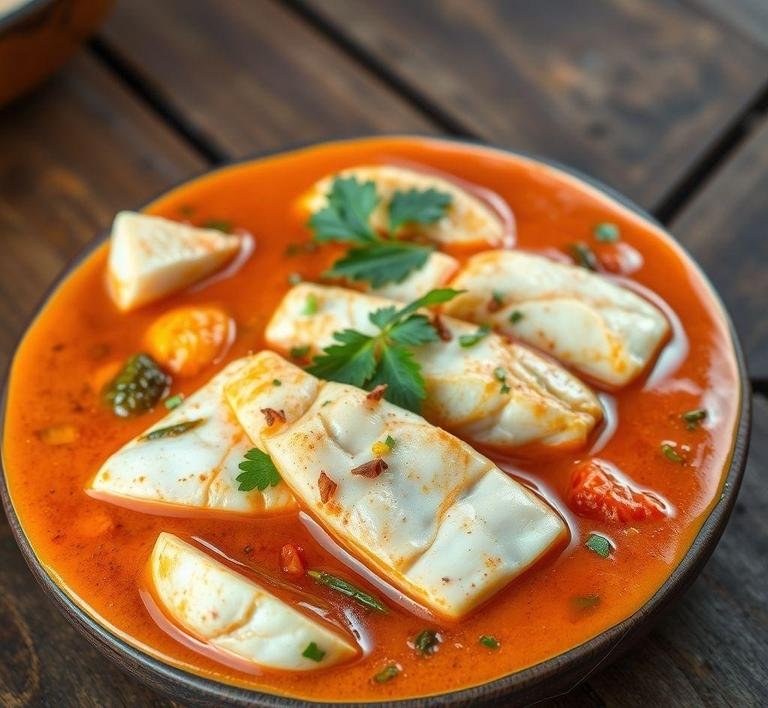Jamie Oliver’s Keralan Fish Curry is a vibrant and flavorful dish inspired by the coastal region of Kerala in southern India. Known for its rich, aromatic curries, Kerala is a place where the flavors of fresh seafood, coconut milk and spices come together perfectly. Jamie’s version of this dish captures the essence of Keralan cooking, blending those distinctive flavors into a delightful, easy-to-make curry.
At the heart of this curry is a delicate, flaky white fish (like cod or haddock), simmered in a fragrant, spiced coconut milk broth. The use of curry leaves, mustard seeds and fresh chilies gives the dish a perfect balance of heat, aroma and creaminess. It’s also packed with bright, tangy notes from ingredients like lime and tamarind.
It’s a simple yet deeply satisfying dish that transports you straight to the tropical coast of India. What makes it even better is the use of fresh, accessible ingredients that most home cooks can find at their local store, making it approachable without losing the authenticity of Keralan flavors.
Jamie Oliver Keralan Fish Curry Recipe
Ingredients Needed
You’ll need a mix of fresh, aromatic and bold ingredients to make Jamie Oliver’s Keralan Fish Curry:
- White Fish Fillets: Any firm white fish will work well, such as cod, haddock or tilapia. These have a mild taste that absorbs the curry’s flavors beautifully.
- Coconut Milk: Full-fat coconut milk is essential to create that creamy base and rich texture. It also gives the curry its signature velvety feel.
- Onions and Garlic: Chopped onions and minced garlic form the base of the curry, adding depth and savory sweetness.
- Ginger: Fresh ginger gives the curry a subtle heat and fragrance that’s so characteristic of Indian cooking.
- Curry Leaves: These leaves are a staple in Kerala cooking and impart a unique, aromatic flavor that you can’t replicate with anything else.
- Mustard Seeds: These are often used in Indian cooking for tempering and add a nutty, slightly pungent flavor when fried.
- Tamarind Paste: This tangy ingredient brightens up the curry and adds a sour kick, balancing out the richness of the coconut milk.
- Chilies: Fresh green chilies provide a bit of heat but the dish isn’t overly spicy. just enough to make it exciting.
- Tomatoes: Fresh tomatoes bring a little acidity to balance the sweetness of the coconut milk.
- Lime: Fresh lime juice adds an extra zing, cutting through the creaminess and giving the curry a fresh, bright finish.
- Spices: Turmeric, ground coriander and cumin are the key spices in this curry, giving it both warmth and a complex flavor profile.
Equipment Needed
Making this dish is simple and the tools you need are likely things you already have in your kitchen. Here’s what you’ll need:
- Large Pan or Wok: A big, wide pan or wok is ideal for frying the spices and cooking the fish. It gives you enough room to stir everything around without making a mess.
- Knife and Chopping Board: For chopping your onions, garlic, ginger, tomatoes and fish fillets.
- Measuring Spoons: For precise measurements of spices and tamarind paste.
- Lid for Pan: You’ll need a lid to cover the pan while the curry simmers, helping the fish cook through gently.
- Wooden Spoon: A wooden spoon is great for stirring everything gently without breaking the fish apart.
How To Make Jamie Oliver’s Keralan Fish Curry
- Prep the Ingredients: Start by chopping your onions, garlic, ginger and tomatoes. Cut the fish fillets into bite-sized pieces. Set everything aside, so you have all your ingredients ready to go.
- Tempering Spices: Heat some oil in your pan. Once hot, add mustard seeds. Wait for them to pop, then add the curry leaves. Sauté these for about a minute until they release their fragrance.
- Building the Base: Next, add the chopped onions, garlic and ginger to the pan. Cook them down until softened and golden. This will form the savory base of your curry.
- Add Tomatoes & Spices: Stir in the chopped tomatoes, turmeric, ground coriander and cumin. Let everything cook down until the tomatoes break down and release their juices, creating a thick, flavorful paste.
- Add Coconut Milk: Pour in the coconut milk and bring the mixture to a gentle simmer. This is where the dish really starts to come together and you’ll notice how rich and creamy the sauce becomes.
- Cook the Fish: Gently place the fish fillets into the curry. Cover the pan and let the fish cook in the coconut sauce. This only takes about 5-7 minutes, depending on the thickness of your fish.
- Finishing Touches: Once the fish is cooked through, stir in tamarind paste and lime juice. Taste the curry and adjust seasoning with salt or more lime if needed.
- Serve: Serve the curry over steamed rice and garnish with fresh cilantro and extra lime wedges.
What I Learnt

Making Jamie Oliver’s Keralan Fish Curry taught me just how balanced a curry can be. It’s a perfect blend of rich creaminess from the coconut milk, a deep umami from the mustard seeds and curry leaves and a light kick of heat from the chilies. The tamarind gives it that tangy punch while the lime brightens everything up.
What stood out most was how simple yet powerful the spices are. With just a handful of ingredients, you can create a complex, flavorful dish that feels like it took hours to make but in reality, it comes together in under 30 minutes. I also learned that this recipe is very forgiving, allowing you to tweak the heat and acidity to suit your taste.
Recipe Tweaks For Jamie Oliver’s Keralan Fish Curry
Jamie Oliver’s Keralan Fish Curry is a vibrant dish full of bold flavors-spicy, tangy and creamy. But as with any recipe, there’s always room for some creative adjustments. Here are a few tweaks you can try to make it your own:
- Fish Choice: While Jamie uses white fish like cod or haddock, you could switch it up. Try adding salmon for a richer taste or sea bass for a firmer texture. If you’re into sustainability, consider using local fish or whatever’s freshest at your market. You can also make this curry with shrimp or scallops if you prefer seafood with a bit of bite.
- Coconut Milk Variations: The recipe calls for coconut milk but you can play around with this too. Swap light coconut milk for a lower-fat version if you’re looking to cut some calories. Alternatively, use coconut cream for a richer, creamier texture. For a more tangy kick, add a splash of tamarind paste to balance out the richness.
- Spices: The curry already has a killer spice mix but if you want it extra fiery, add green chilies or a dash of cayenne pepper. For a deeper flavor, toast the coriander seeds and cumin before grinding them. This step unlocks even more aroma and flavor.
- Herbs: If you want to introduce more herbs, throw in some curry leaves or fresh cilantro towards the end of cooking. You could also go for a few sprigs of mint for a fresh, cooling contrast to the heat of the curry.
- Add a Sweet Element: Keralan dishes often balance spiciness with a hint of sweetness. Try adding a small piece of palm sugar or a spoon of jaggery to mellow the heat without overpowering the curry’s balance.
- Vegetables: For a heartier dish, consider adding in some sweet potatoes, spinach or okra. These vegetables soak up the curry’s spices, adding more depth and texture.
Storage Tips For Leftovers
If you have leftovers (and let’s face it, you probably will. this curry makes great portions!), you’ll want to store them properly so they last without losing any flavor.
- Cool Down: Always let the curry cool to room temperature before storing it. Hot food can create moisture inside the container which could lead to sogginess and spoilage.
- Airtight Containers: Use airtight containers to keep the curry fresh. Glass containers are great because they don’t absorb smells or stain but plastic will do the job too if it’s sealed tightly.
- Refrigerating: Store your curry in the fridge for up to 2 days. Beyond that, the flavor may start to degrade and the fish might lose its freshness.
- Freezing: If you want to extend the life of your leftovers, this curry freezes really well. Portion it into smaller containers and it should last for about 1-2 months. When reheating, do so gently on low heat to avoid overcooking the fish.
- Reheating Tips: When reheating, you can add a splash of water or extra coconut milk to loosen the curry back up. Fish can become rubbery if reheated too quickly or at too high a temperature, so go low and slow.
What To Eat With Jamie Oliver’s Keralan Fish Curry?
Pairing the right sides with this curry can elevate the whole meal. Here are some suggestions to bring out the best in Jamie Oliver’s Keralan Fish Curry:
- Steamed Rice: The classic pairing. Basmati rice works perfectly because it’s fluffy and aromatic. You can even opt for coconut rice if you want to double down on the coconut flavor. The rice will absorb the curry sauce beautifully.
- Indian Flatbreads: If you’re more into bread than rice, naan or roti are great choices. The soft, warm texture of the bread is perfect for scooping up the curry.
- Mango Chutney: The sweet-and-tangy mango chutney will add another layer of flavor and freshness. It also provides a nice balance to the curry’s spice.
- Raita: A cool yogurt-based raita with cucumber, mint and cumin will help tone down the heat of the curry while refreshing your palate between bites.
- Vegetable Sides: A simple salad with a tangy lime dressing or a lightly sautéed vegetable medley (think beans, carrots or even cauliflower) would pair nicely without overpowering the main dish.
- Pickles: Keralan cuisine often features pickles and a small bowl of lime pickle or mango pickle on the side would bring a zesty contrast to the richness of the curry.
FAQs
What Type Of Fish Is Best For Jamie Oliver’s Keralan Fish Curry?
White fish like cod, haddock, or tilapia works great, but you can also use firm fish like monkfish or sea bass.
Can I Make Jamie Oliver’s Keralan Fish Curry Without Coconut Milk?
Coconut milk is key for that creamy texture and flavor, but you can substitute it with a dairy-free cream or a mix of vegetable stock and almond milk if needed.
How Spicy Is Jamie Oliver’s Keralan Fish Curry?
It’s got a nice kick but not overwhelmingly spicy. You can adjust the chili to your taste if you prefer it milder or hotter.


